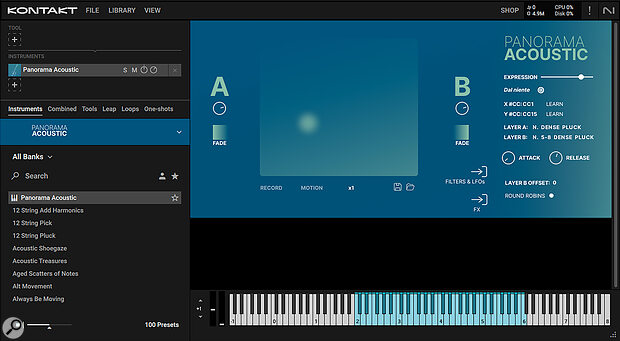Rating: 4.5/5 Stars
Requiring NI’s Kontakt 8 or the free Kontakt Player 8.1, Panorama Acoustic utilises the same dual‑voice Aria engine as Sonora Cinematic’s previous Panorama instruments. This time, though, the sample set is based on acoustic guitars comprising a nylon‑strung model, a steel‑strung instrument and a 12‑string. These are all sampled in detail and were played by musician Matteo Nahum. As expected from Sonora Cinematic, the sounds also include heavily processed examples that slot into cinematic and chill‑out compositions as well as more mainstream music. A range of presets covers both lightly processed and heavily disguised examples of these instruments, and as the underlying Aria engine supports the drag‑and‑drop import of the user’s own samples into either or both layers, there’s a lot of creative potential here. Note, however, that although user samples can be looped if required, loop points are not imported and there are no tools for smoothing the loop transitions.
The Aria engine offers two customisable layers with a central control pad that can be used to blend, stack or crossfade layers by moving the control puck in the X axis; the Y axis controls other parameters relating to the filter, volume, panning and so on. X/Y motions can be recorded and saved as user presets so that the path is traced every time a new note is played. Rotary controls access attack and release, with further tabs to access the controls for filters/LFOs and effects. The A and B samples can be set individually to fade as the X/Y pad is moved, or can be left fixed.
Ranging from natural to ethereal, aggressive to ambient, Panorama Acoustic has a lot to offer, especially given its modest cost.
Though only three guitars were sampled, these have different picked and plucked articulations, harmonics and even an EBow sample. The source samples include straight and processed sounds with a few using granular processing, so it is possible to conjure up sounds that stray a long way from the guitars that created them. With over 100 factory presets, it is evident just how varied the sounds can be, and they include what Sonora Cinematic call Impros, which are simple rhythmic repeats built using unison, fifth and octave notes that follow the original note. It’s worth mentioning, though, that the Impros are not locked to DAW tempo. In most cases the Impro follows after a short delay and usually at a lower level, allowing it to sit naturally in the mix. This also allows the user to include shorter notes that end before the Impros start. The Natural Impros section is further divided into Root/Fifth/Octave and repeated Single Notes. The other categories cover Motions, Single Strokes, Sound Design and, for two of the guitars, Tremolos. Ranging from natural to ethereal, aggressive to ambient, Panorama Acoustic has a lot to offer, especially given its modest cost.

